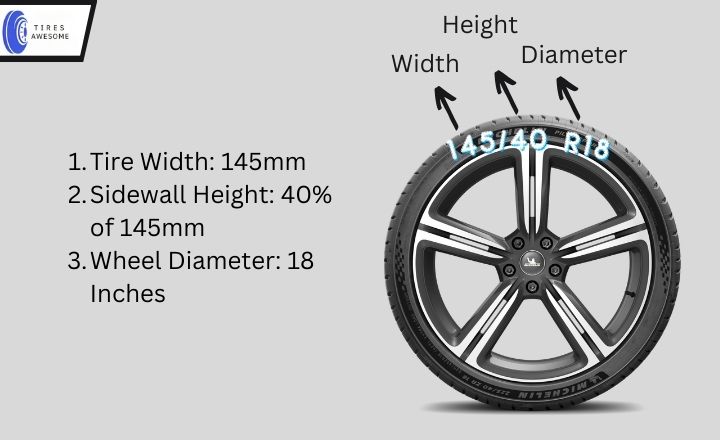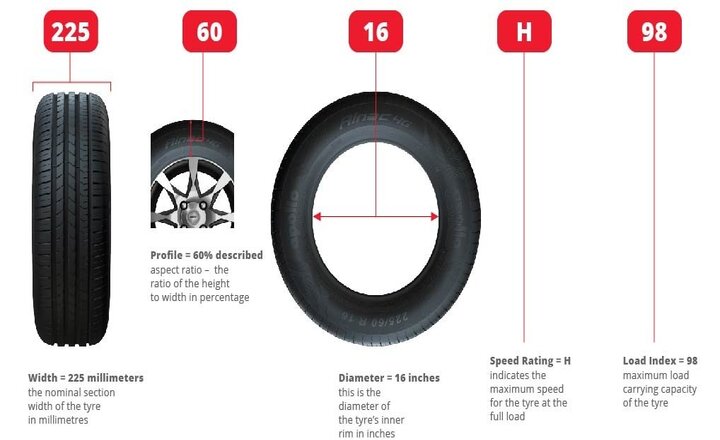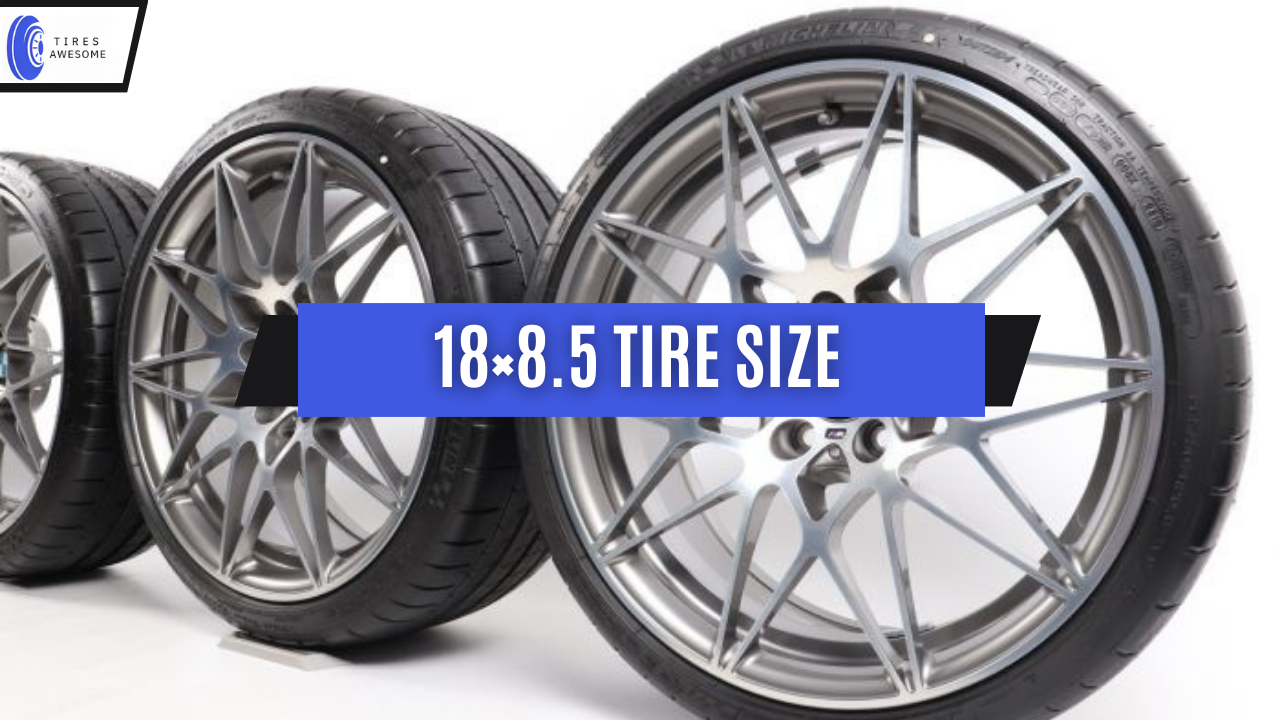As for finding the right tire size to fit your specific rims, as a tire expert, I’ll give you accurate information about the 18×8.5 tire size. This article will help you find the best tires for 18×8.5 wheels. It covers everything from grip and handling to tread patterns and tire width. You’ll learn to choose the right tires to improve your car’s look and performance.
What Do 18×8.5 Rims Mean?
“18x8.5 inch rims” refers to the wheel rim size commonly used in the automotive industry. The number “18” represents the rim’s diameter, measured in inches. The measurement “8.5” denotes the width of the edge and is also expressed in inches.
What Size Tire Fits A 18×8.5 Wheel?
Choosing the correct tire size 18×8.5 is essential for optimal safety, handling, and performance. The most common options recommended tires for 18×8.5 wheels include:
225/40R18: This tire size balances stability and responsiveness on the road.
235/40R18: Known for its enhanced traction and improved cornering capabilities
245/40R18: Provides a broader contact patch for better grip and increased stability during acceleration and braking.
255/40R18: A slightly wider profile enhances performance and aesthetics.
265/35R18: With a lower aspect ratio, this size provides sportier handling characteristics.
Guide To Reading Tire Sizes:
Decoding tire sizing can be challenging, so here’s a concise guide to understanding the pattern on your tire:
- The first number represents the tire width in millimetres. This measurement indicates how wide the tire is from sidewall to sidewall.
- The second number denotes the sidewall height as a percentage of the tire width. For example, if the second number is 65, the sidewall’s size is 65% of the tire’s width.
- The last number specifies the recommended wheel diameter in inches.
Let’s take the example of a 145/40/R18 tire. The first number, 145, represents the tire’s width in millimetres. The number 40 signifies the aspect ratio, which relates to the balance of the height of the sidewall to its width. It means that the size is equivalent to 40% of its width.
We encounter R18, which stands for radial construction and indicates that this particular tire model fits a wheel diameter of 18 inches.

For 18×8.5 Wheels, What Size Tire Is Best?
The 235/40/R18 is a popular, balanced option that compromises performance and daily driving comfort. It’s essential to consider your specific needs and preferences before deciding.
Wider tires generally provide the following:
- Improved grip and traction.
- Leading to more confident handling.
- Better manoeuvrability.
- Some fuel efficiency is due to increased rolling resistance.
Narrower tires offer improved fuel economy and a smoother ride due to reduced friction with the road surface.
What Are The Most Considerable 18×8.5 Tire Sizes?
Regarding 18×8.5 wheels, the maximum tire size recommended for these rims is 255/35/R18. While the general range for tire width on 18×8.5 edges usually falls between 225 and 255, some specific individuals may be inclined to explore beyond the conventional limits.

These issues may include compromised handling, potential rubbing against the wheel well, and even potential damage to the tire. It is highly advised to seek guidance from a professional mechanic or tire expert to install wider tires on your vehicle.
Do Wider Tires Offer More Traction?
By increasing the contact patch between the tire and the road, a wider tire allows for more surface area to grip the road’s surface. This increased grip means more traction is available, which improves stability and control while driving.
When a car turns or accelerates, the tires must maintain their grip on the road to prevent sliding or losing control. With wider tires, a larger contact patch is available for gripping the road, reducing the chances of slipping.
Do Wider Tires Handle Better?
Wider tires have stiffer sidewalls that reduce flex during cornering, improving stability and grip. Wider tires distribute the car’s weight more evenly, resulting in better handling and reduced weight transfer while turning.
This enhanced weight distribution allows for increased traction and control during cornering manoeuvres. The larger contact patch of wider tires provides more surface area in contact with the road, further enhancing grip and ensuring improved handling capabilities.
Do Wider Tires Look Better?
They offer various advantages, but the aesthetically pleasing nature of wide tires captures our attention. From the rearview, a car equipped with wider tires appears more assertive and purposeful. The additional width extends beyond the vehicle’s body, creating an impression of stability and power.
Indeed, beauty lies in the eye of the beholder, but wide tires have an almost universal visual appeal. They enhance the car’s overall stance, giving it a hunkered-down appearance that suggests readiness for action.
Do Wider Tires Use More Fuel?
Wider tires can impact fuel efficiency because they are larger and heavier. Their increased width means they occupy more space on the road and require more force to turn, leading to higher levels of rolling resistance. This resistance requires more energy from your engine, increasing fuel consumption.
The added weight of wider tires further contributes to reduced fuel efficiency. These factors suggest that wider tires generally use more fuel than narrower ones.
Do Wider Tires Accelerate Slower?
The broader surface area of wider tires requires additional force, or “oomph,” to set them in motion. This translates into a more significant requirement for energy to accelerate the vehicle. It can be likened to the challenge of turning a heavier and larger tire, which demands more effort.
Wider tires generally exhibit slower acceleration times compared to narrower ones. Drivers prioritize quickly, requiring comparatively less energy during the initial propulsion phase.
Engine power, transmission efficiency, weight distribution, and aerodynamics significantly determine how quickly a vehicle can reach higher speeds.
What Is The Smallest Wheel 18×8.5 Tires Size?
Considering the 18×8.5 tires may also have various speed ratings and load capacities, allowing drivers to choose according to their vehicle’s requirements., it is recommended to go with 225/40/R18 tires. Ride quality could be compromised as smaller tires have less sidewall height, reducing cushioning and potential discomfort on rough roads.

Opting for a smaller size can diminish sidewall protection, leaving the wheel vulnerable to damage from obstacles or curb impacts. Using smaller tires might affect speedometer readings as the tires’ circumference decreases, leading to potentially inaccurate speed measurements.
Final Thoughts
Understanding tire sizes and their compatibility with specific rim measurements is crucial for ensuring optimal performance and safety on the road. The 18×8.5 tire size is commonly found on various vehicles, including sedans and SUVs. This car is suitable for driving every day and sometimes going off-road. When you buy tires for 18 8.5 wheels, check what the car maker recommends to ensure they fit right and don’t cause problems. Getting the right tire size for 18×8.5 of your wheels can improve your car’s handle, ride more comfortably, and improve its performance.
FAQs
Is The Rim Size And Wheel Size The Same?
The diameter of a wheel or rim is the distance, measured in inches, from bead seat to bead seat across the face of the wheel. This measurement is used because it represents where the tire and wheel meet. In this example, the diameter is 16 inches.
How Many Wheels Does An 18 Have?
An 18-wheeler, also called a semi-truck, has 18 wheels. It has 10 wheels on the front part with the engine and 8 wheels on the trailer. These many wheels help distribute the weight of the truck and its cargo evenly, making it more stable and able to carry heavier loads.
How Many Times Can I Fit Tires?
It is advisable to choose ones with a diameter (height) measurement that is no more than 3 percent different from your current tires’ diameter, as long as they align with the specifications mentioned in your owner’s manual.

